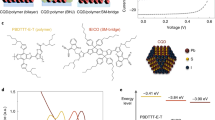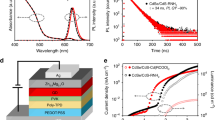Abstract
Luminescent solar concentrators serving as semitransparent photovoltaic windows could become an important element in net zero energy consumption buildings of the future. Colloidal quantum dots are promising materials for luminescent solar concentrators as they can be engineered to provide the large Stokes shift necessary for suppressing reabsorption losses in large-area devices. Existing Stokes-shift-engineered quantum dots allow for only partial coverage of the solar spectrum, which limits their light-harvesting ability and leads to colouring of the luminescent solar concentrators, complicating their use in architecture. Here, we use quantum dots of ternary I–III–VI2 semiconductors to realize the first large-area quantum dot–luminescent solar concentrators free of toxic elements, with reduced reabsorption and extended coverage of the solar spectrum. By incorporating CuInSexS2–x quantum dots into photo-polymerized poly(lauryl methacrylate), we obtain freestanding, colourless slabs that introduce no distortion to perceived colours and are thus well suited for the realization of photovoltaic windows. Thanks to the suppressed reabsorption and high emission efficiencies of the quantum dots, we achieve an optical power efficiency of 3.2%. Ultrafast spectroscopy studies suggest that the Stokes-shifted emission involves a conduction-band electron and a hole residing in an intragap state associated with a native defect.
This is a preview of subscription content, access via your institution
Access options
Subscribe to this journal
Receive 12 print issues and online access
$259.00 per year
only $21.58 per issue
Buy this article
- Purchase on Springer Link
- Instant access to full article PDF
Prices may be subject to local taxes which are calculated during checkout





Similar content being viewed by others
References
Debije, M. G. & Verbunt, P. P. C. Solar concentrators: thirty years of luminescent solar concentrator research: solar energy for the built environment. Adv. Energ. Mater. 2, 12–35 (2012).
Currie, M. J., Mapel, J. K., Heidel, T. D., Goffri, S. & Baldo, M. A. High-efficiency organic solar concentrators for photovoltaics. Science 321, 226–228 (2008).
Rau, U., Einsele, F. & Glaeser, G. C. Efficiency limits of photovoltaic fluorescent collectors. Appl. Phys. Lett. 87, 171101 (2005).
Van Sark, W. G. J. H. M. et al. Luminescent solar concentrators—a review of recent results. Opt. Express 16, 21773–21792 (2008).
Zhao, Y., Meek, G. A., Levine, B. G. & Lunt, R. R. Near-infrared harvesting transparent luminescent solar concentrators. Adv. Opt. Mater. 2, 606–611 (2014).
Giebink, N. C., Wiederrecht, G. P. & Wasielewski, M. R. Resonance-shifting to circumvent reabsorption loss in luminescent solar concentrators. Nature Photon. 5, 694–701 (2011).
Desmet, L., Ras, A. J. M., de Boer, D. K. G. & Debije, M. G. Monocrystalline silicon photovoltaic luminescent solar concentrator with 4.2% power conversion efficiency. Opt. Lett. 37, 3087–3089 (2012).
Wang, T. et al. Luminescent solar concentrator employing rare earth complex with zero self-absorption loss. Sol. Energy 85, 2571–2579 (2011).
Debije, M. G. et al. Promising fluorescent dye for solar energy conversion based on a perylene perinone. Appl. Opt. 50, 163–169 (2011).
Krumer, Z. et al. Tackling self-absorption in luminescent solar concentrators with type-II colloidal quantum dots. Sol. Energy Mater. Sol. Cell 111, 57–65 (2013).
Bomm, J. et al. Fabrication and full characterization of state-of-the-art quantum dot luminescent solar concentrators. Sol. Energy Mater. Sol. Cell. 95, 2087–2094 (2011).
Chatten, A. J., Barnham, K. W. J., Buxton, B. F., Ekins-Daukes, N. J. & Malik, M. A. Quantum dot solar concentrators. Semiconductors 38, 909–917 (2004).
Gallagher, S. J., Norton, B. & Eames, P. C. Quantum dot solar concentrators: electrical conversion efficiencies and comparative concentrating factors of fabricated devices. Sol. Energy 81, 813–821 (2007).
Purcell-Milton, F. & Gun'ko, Y. K. Quantum dots for luminescent solar concentrators. J. Mater. Chem. 22, 16687–16697 (2012).
Meinardi, F. et al. Large area luminescent solar concentrators based on ‘Stokes-shift-engineered’ nanocrystals in a mass polymerized PMMA matrix. Nature Photon. 8, 392–399 (2014).
Bradshaw, L. R., Knowles, K. E., McDowall, S. & Gamelin, D. R. Nanocrystals for luminescent solar concentrators. Nano Lett. 15, 1315–1323 (2015).
Erickson, C. S. et al. Zero-reabsorption doped-nanocrystal luminescent solar concentrators. ACS Nano 8, 3461–3467 (2014).
Coropceanu, I. & Bawendi, M. G. Core/shell quantum dot based luminescent solar concentrators with reduced reabsorption and enhanced efficiency. Nano Lett. 14, 4097–4101 (2014).
Cirloganu, C. M. et al. Enhanced carrier multiplication in engineered quasi-type-II quantum dots. Nature Commun. 5, 4148 (2014).
Lin, Q. et al. Design and synthesis of heterostructured quantum dots with dual emission in the visible and infrared. ACS Nano 9, 539–547 (2015).
Aldakov, D., Lefrancois, A. & Reiss, P. Ternary and quaternary metal chalcogenide nanocrystals: synthesis, properties and applications. J. Mater. Chem. C 1, 3756–3776 (2013).
Kolny-Olesiak, J. & Weller, H. Synthesis and application of colloidal CuInS2 semiconductor nanocrystals. ACS Appl. Mater. Interfaces 5, 12221–12237 (2013).
Li, L. et al. Efficient synthesis of highly luminescent copper indium sulfide-based core/shell nanocrystals with surprisingly long-lived emission. J. Am. Chem. Soc. 133, 1176–1179 (2011).
Akkerman, Q. A. et al. From binary Cu2S to ternary Cu–In–S and quaternary Cu–In–Zn–S nanocrystals with tunable composition via partial cation exchange. ACS Nano 9, 521–531 (2015).
Zhong, H. et al. Noninjection gram-scale synthesis of monodisperse pyramidal CuInS2 nanocrystals and their size-dependent properties. ACS Nano 4, 5253–5262 (2010).
McDaniel, H., Fuke, N., Makarov, N. S., Pietryga, J. M. & Klimov, V. I. An integrated approach to realizing high-performance liquid-junction quantum dot sensitized solar cells. Nature Commun. 4, 2887 (2013).
McDaniel, H., Fuke, N., Pietryga, J. M. & Klimov, V. I. Engineered CuInSexS2–x quantum dots for sensitized solar cells. J. Chem. Phys. Lett. 4, 355–361 (2013).
Yarema, O. et al. Highly luminescent, size- and shape-tunable copper indium selenide based colloidal nanocrystals. Chem. Mater. 25, 3753–3757 (2013).
McDaniel, H. et al. Simple yet versatile synthesis of CuInSexS2–x quantum dots for sunlight harvesting. J. Phys, Chem. C 118, 16987–16994 (2014).
Panthani, M. G. et al. Synthesis of CuInS2, CuInSe2, and Cu(InxGa1–x)Se2 (CIGS) nanocrystal ‘inks’ for printable photovoltaics. J. Am. Chem. Soc. 130, 16770–16777 (2008).
García-Santamaría, F. et al. Breakdown of volume scaling in Auger recombination in CdSe/CdS heteronanocrystals: the role of the core–shell interface. Nano Lett. 11, 687–693 (2011).
Stewart, J. T. et al. Comparison of carrier multiplication yields in PbS and PbSe nanocrystals: the role of competing energy-loss processes. Nano Lett. 12, 622–628 (2011).
Semonin, O. E. et al. Absolute photoluminescence quantum yields of IR-26 dye, PbS, and PbSe quantum dots. J. Chem. Phys. Lett. 1, 2445–2450 (2010).
Chen, B. et al. Highly emissive and color-tunable CuInS2-based colloidal semiconductor nanocrystals: off-stoichiometry effects and improved electroluminescence performance. Adv. Funct. Mater. 22, 2081–2088 (2012).
De Trizio, L. et al. Strongly fluorescent quaternary Cu–In–Zn–S nanocrystals prepared from Cu1–xInS2 nanocrystals by partial cation exchange. Chem. Mater. 24, 2400–2406 (2012).
Bomm, J. et al. Fabrication and spectroscopic studies on highly luminescent CdSe/CdS nanorod polymer composites. Beilstein J. Nanotechnol. 1, 94–100 (2010).
Bronstein, N. D. et al. Luminescent solar concentration with semiconductor nanorods and transfer-printed micro-silicon solar cells. ACS Nano 8, 44–53 (2013).
Shcherbatyuk, G. V., Inman, R. H., Wang, C., Winston, R. & Ghosh, S. Viability of using near infrared PbS quantum dots as active materials in luminescent solar concentrators. Appl. Phys. Lett. 96, 191901 (2010).
Slooff, L. H. et al. A luminescent solar concentrator with 7.1% power conversion efficiency. Phys. Status Solidi Rapid Res. Lett. 2, 257–259 (2008).
Hunter, R. S. Photoelectric color-difference meter. J. Opt. Soc. Am. 38, 985–993 (1948).
Witt, E. & Kolny-Olesiak, J. Recent developments in colloidal synthesis of CuInSe2 nanoparticles. Chem. Eur. J. 19, 9746–9753 (2013).
Rice, W. D., McDaniel, H., Klimov, V. I. & Crooker, S. A. Magneto-optical properties of CuInS2 nanocrystals. J. Chem. Phys. Lett. 5, 4105–4109 (2014).
Meier, C., Gondorf, A., Lüttjohann, S., Lorke, A. & Wiggers, H. Silicon nanoparticles: absorption, emission, and the nature of the electronic bandgap. J. Appl. Phys. 101, 103112 (2007).
Lee, D. C. et al. Colloidal synthesis of infrared-emitting germanium nanocrystals. J. Am. Chem. Soc. 131, 3436–3437 (2009).
Kim, S., Fisher, B., Eisler, H.-J. & Bawendi, M. Type-II quantum dots: CdTe/CdSe(core/shell) and CdSe/ZnTe(core/shell) heterostructures. J. Am. Chem. Soc. 125, 11466–11467 (2003).
Viswanatha, R., Brovelli, S., Pandey, A., Crooker, S. A. & Klimov, V. I. Copper-doped inverted core/shell nanocrystals with ‘permanent’ optically active holes. Nano Lett. 11, 4753–4758 (2011).
Pandey, A. et al. Long-lived photoinduced magnetization in copper-doped ZnSe–CdSe core–shell nanocrystals. Nature Nanotech. 7, 792–797 (2012).
Binsma, J. J. M., Giling, L. J. & Bloem, J. Luminescence of CuInS2: I. The broad band emission and its dependence on the defect chemistry. J. Lumin. 27, 35–53 (1982).
Şahin, D., Ilan, B. & Kelley, D. F. Monte-Carlo simulations of light propagation in luminescent solar concentrators based on semiconductor nanoparticles. J. Appl. Phys. 110, 033108 (2011).
Acknowledgements
S.B. and F.M. acknowledge support from the Cariplo Foundation (2012-0844). V.I.K., H.M., K.A.V. and N.S.M. were supported by the Center for Advanced Solar Photophysics (CASP), an Energy Frontier Research Center funded by the Office of Basic Energy Sciences, Office of Science, US Department of Energy. S.B. acknowledges financial support from the European Community's Seventh Framework Programme (FP7/2007–2013) under grant agreement no. 324603 (EDONHIST). The authors thank M. Acciarri and the staff of the MIB-SOLAR laboratory for technical assistance in the quantitative studies of solar concentration and L. Raimondo and V. Pinchetti for assistance with the colorimetric analysis.
Author information
Authors and Affiliations
Contributions
The experiment designs were the result of ongoing interactions and discussions between F.M., V.I.K. and S.B. H.M. optimized and synthesized the quantum dots. F.C. fabricated the quantum dot–polymer nanocomposites with the assistance of S.B., A.C. and R.S. S.B., F.M., H.M. and V.I.K. planned the experiments. F.C., F.M. and S.B. performed the spectroscopic experiments and characterized the LSCs. K.A.V. performed the Monte Carlo simulations. S.B. and F.M. performed the colorimetric analysis. N.S.M. performed the transient absorption measurement. F.M., V.I.K. and S.B. wrote the paper, in consultation with all the authors.
Corresponding authors
Ethics declarations
Competing interests
The authors declare no competing financial interests.
Supplementary information
Supplementary information
Supplementary information (PDF 970 kb)
Rights and permissions
About this article
Cite this article
Meinardi, F., McDaniel, H., Carulli, F. et al. Highly efficient large-area colourless luminescent solar concentrators using heavy-metal-free colloidal quantum dots. Nature Nanotech 10, 878–885 (2015). https://doi.org/10.1038/nnano.2015.178
Received:
Accepted:
Published:
Issue Date:
DOI: https://doi.org/10.1038/nnano.2015.178
This article is cited by
-
Luminescent solar concentrator efficiency enhanced via nearly lossless propagation pathways
Nature Photonics (2024)
-
A comprehensive dataset of photonic features on spectral converters for energy harvesting
Scientific Data (2024)
-
Near-infrared photon upconversion and solar synthesis using lead-free nanocrystals
Nature Photonics (2023)
-
Coherent heteroepitaxial growth of I-III-VI2 Ag(In,Ga)S2 colloidal nanocrystals with near-unity quantum yield for use in luminescent solar concentrators
Nature Communications (2023)
-
Synthesis and optical properties of II–VI semiconductor quantum dots: a review
Journal of Materials Science: Materials in Electronics (2023)



